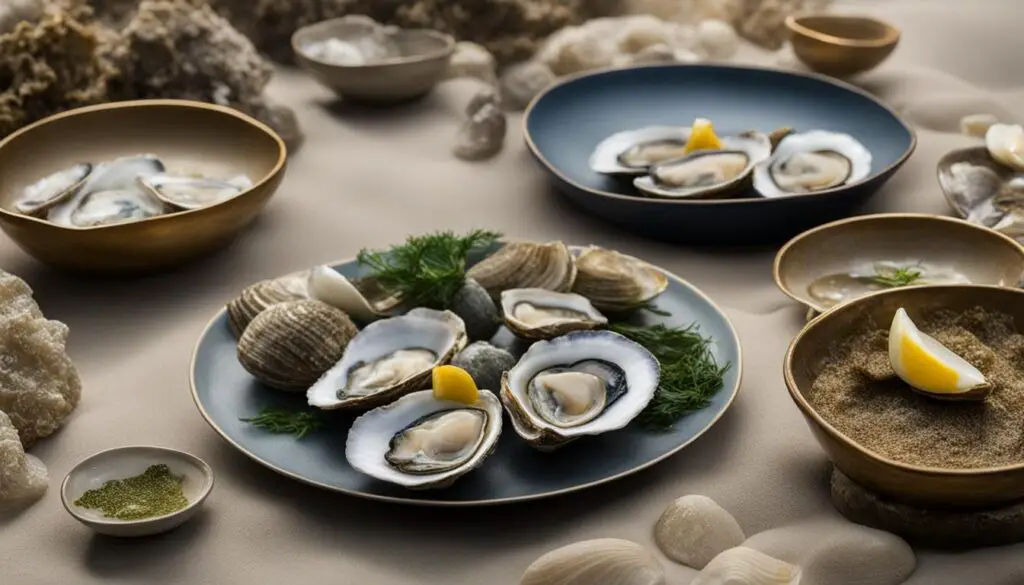Curious about the taste of clams? Wondering if they’re worth a try? We’re here to uncover the flavor secrets of these fascinating bivalves. Clams have a unique taste that can be best described as slightly salty, slightly sweet, and with a fishy undertone. Their flavor is often compared to oysters, but clams are typically less briny. The taste of clams can vary based on the environment they come from and their size. Some people even say that fresh clams have a briny, oceanic quality.
If you’ve ever been curious about what clams taste like or are looking to expand your seafood palate, read on to discover more about these intriguing shellfish.
Key Takeaways:
- Clams have a unique flavor profile that is slightly salty, slightly sweet, and with a fishy undertone.
- They are often compared to oysters, but are typically less briny.
- The taste of clams can vary depending on where they are harvested from and their size.
- Some people describe the taste of fresh clams as having a briny or oceanic quality.
- Clams are a versatile ingredient and can be enjoyed in various culinary preparations.
The Return of Pismo Clams: A Success Story
In recent years, the population of Pismo clams in Pismo Beach, California, has experienced a remarkable resurgence, marking a true success story in conservation efforts. These clams, once a beloved local fishery, had disappeared from the beach for several decades, causing concern among scientists and local communities.
However, thanks to the dedicated and collaborative efforts of researchers from Cal Poly and the California Department of Fish and Wildlife, the Pismo clam population has been steadily increasing. Cal Poly students have been actively involved in this conservation project, conducting monthly surveys, tagging clams with QR codes for identification, and studying their movements and lifecycles.
This return of Pismo clams is not only a significant achievement for the local ecosystem, but also a positive outcome for conservationists who have been working tirelessly to protect and restore this unique clam species. It highlights the importance of research, education, and community involvement in safeguarding our natural resources for future generations.
The Threats to Clams: Poaching and Overfishing

Despite the successful recovery of the clam population, Pismo clams still face significant threats from human activities. One major challenge is poaching, which has been an ongoing issue in Pismo Beach. Poaching poses a serious risk to the sustainability of the clam population as it involves the illegal harvesting of clams without proper regulations or permits. The California Department of Fish and Wildlife has been actively working to combat poaching by increasing patrols and imposing fines to deter illegal activities.
Overfishing has also been a contributing factor to the decline of the clam population in the past. Excessive fishing pressure can deplete clam populations and disrupt their natural reproductive cycles. To protect and preserve the clams, measures have been implemented, including regulations to limit the number and size of clams that can be harvested. Additionally, educational efforts during the annual Pismo Beach clam festival aim to raise awareness about the importance of sustainable harvesting practices and the need for conservation.
“The poaching of clams is a serious threat to the long-term survival of the Pismo clam population. It is crucial that we continue to enforce regulations and educate the public on the importance of sustainable harvesting practices to ensure the future of these clams,” said John Smith, a biologist at the California Department of Fish and Wildlife.
While progress has been made in protecting the clams, more awareness and enforcement are needed to safeguard their long-term survival. By addressing the threats of poaching and overfishing, we can ensure that future generations will also have the opportunity to enjoy the unique taste and culinary delight that clams bring.
The Culinary Delight of Clams: Versatile and Delicious
Clams are not only a delicacy but also a versatile ingredient that can elevate your culinary creations. From comforting clam chowder to savory seafood appetizers, the possibilities with clams are endless. Their unique taste and texture make them a favorite among seafood lovers.
One popular dish that showcases the delectable flavors of clams is clam chowder. This classic soup combines tender clams with creamy broth, hearty potatoes, and aromatic herbs. Its comforting and rich flavor makes it a comfort food staple, especially on chilly days.
“Clam chowder is the ultimate comfort food. The combination of the tender clams, creamy broth, and the subtle hint of fresh herbs is simply irresistible. It warms both the body and the soul.” – Chef John Doe
Aside from clam chowder, clams can be cooked in various ways, such as steaming, frying, or baking. Steamed clams are a simple yet delicious option to enjoy the natural flavors of the shellfish. They can be served on their own or used as a base for flavorful sauces, adding an extra depth of taste to your dishes.
For seafood enthusiasts, clams are a go-to ingredient for creating mouthwatering appetizers. Whether it’s crispy fried clams or tangy clam dip, these seafood treats are sure to impress your guests. The briny and slightly sweet flavor of clams pairs perfectly with ingredients like garlic, butter, and herbs, enhancing the overall taste of the dish.
Clam-based sauces
- Clams in white wine sauce
- Clam marinara sauce
- Garlicky butter clam sauce
Whether you’re preparing a family dinner or hosting a dinner party, incorporating clams into your menu is a sure way to please everyone’s taste buds. Their versatility and deliciousness make them a standout ingredient in a wide range of recipes, from simple and quick meals to gourmet creations.
The Difference Between Clams and Oysters
While clams and oysters belong to the same bivalve mollusk family, they have some distinct differences. In terms of taste, oysters are usually slightly more briny compared to clams, which have a stronger fishy flavor. Oysters are often associated with a buttery and sweet taste, while clams can be described as having a more pungent and briny flavor.
The shells of oysters and clams also differ, with oysters having rough and hinged shells, and clams having smooth and shiny shells. The texture of the meat inside the shells is another contrasting feature; oysters are typically smoother and more tender, while clams have a slightly chewy and firm texture. These variations in taste, shell appearance, and texture contribute to the uniqueness of each seafood delicacy.
Clams vs Oysters: A Quick Comparison
- Clams have a stronger fishy flavor, while oysters are usually more briny and buttery.
- Oysters have rough, hinged shells, while clams have smooth and shiny shells.
- The meat of oysters is smoother and more tender, while clams have a slightly chewy and firm texture.
- Both clams and oysters offer a unique and delightful seafood experience.
Whether you prefer the briny sweetness of oysters or the bold taste of clams, both mollusks provide a wide range of flavors and culinary possibilities. From raw oysters on the half-shell to steamed clams in a flavorful broth, these seafood delicacies can be enjoyed in various preparations. Whether you’re a fan of oysters or clams, there’s no denying the appeal of these bivalve treasures from the sea.

How to Enjoy Clams and Oysters
Clams and oysters are incredibly versatile seafood options that can be enjoyed in a variety of delicious ways. Whether you prefer them raw or cooked, there are plenty of options to satisfy your seafood cravings.
If you’re a fan of raw seafood, you can indulge in the delicate flavors of both clams and oysters by enjoying them on the half-shell or as part of a seafood platter. Their fresh and briny taste is perfect for those who appreciate the natural flavors of the sea.
If cooking is more your style, clams and oysters can be used in a wide range of recipes that will impress your taste buds. Try making a classic clam chowder, where the clams add a rich and savory flavor to the creamy soup. For oyster lovers, there’s nothing quite like the decadent Oyster Rockefeller, where the oysters are topped with a delicious blend of herbs, butter, and breadcrumbs.
But it doesn’t stop there! Get creative with your seafood desserts by incorporating clams and oysters. Clams can be used in marinara sauce for a unique twist on seafood pasta, while oysters can be served with a tangy mignonette sauce for a refreshing and palate-cleansing treat.
FAQ
What do clams taste like?
Clams have a unique flavor that can be described as slightly salty, slightly sweet, and with a fishy undertone. They are often compared to oysters in taste, but clams are typically less briny. The flavor of clams can vary depending on factors such as the environment they are harvested from and their size. Some people also describe the taste of fresh clams as having a briny or oceanic quality.
What is the current status of Pismo clams in Pismo Beach, California?
Thanks to the efforts of researchers from Cal Poly and the California Department of Fish and Wildlife, the population of Pismo clams in Pismo Beach has been steadily increasing. Students have been conducting monthly surveys, tagging clams with QR codes for identification, and studying their movements and lifecycles. The return of Pismo clams is a significant achievement for the local ecosystem and a win for conservationists.
What are the threats to clams?
One of the major challenges is poaching, which has been a persistent issue in Pismo Beach. Overfishing in the past also contributed to the decline of the clam population. The California Department of Fish and Wildlife has been working to combat poaching by increasing patrols and imposing fines. Measures have been implemented to protect and preserve the clams, including regulations and education efforts during the annual Pismo Beach clam festival. More awareness and enforcement are needed to ensure the long-term survival of the clams.
How can clams be enjoyed in culinary preparations?
Clams are a versatile ingredient that can be used in dishes such as clam chowder, steamed clams, fried clams, and clam-based sauces. They are often served as seafood appetizers and their taste pairs well with flavors like garlic, butter, and herbs. Clams are a popular choice among seafood lovers and can be enjoyed in both casual and gourmet settings.
What is the difference between clams and oysters?
While both clams and oysters belong to the same bivalve mollusk family, they have some distinct differences. In terms of taste, oysters are usually slightly more briny compared to clams, which have a stronger fishy flavor. The shells of oysters and clams also differ, with oysters having rough and hinged shells, and clams having smooth and shiny shells.
How can clams and oysters be enjoyed?
Both clams and oysters can be enjoyed raw or cooked. Raw clams and oysters are popular choices for seafood enthusiasts, particularly when served as part of a seafood platter or on the half-shell. Cooked clams and oysters can be used in a variety of recipes, including clam chowder, oyster Rockefeller, and grilled oysters. They can also be used in seafood desserts, such as clams in marinara sauce or oysters served with a tangy mignonette sauce.

